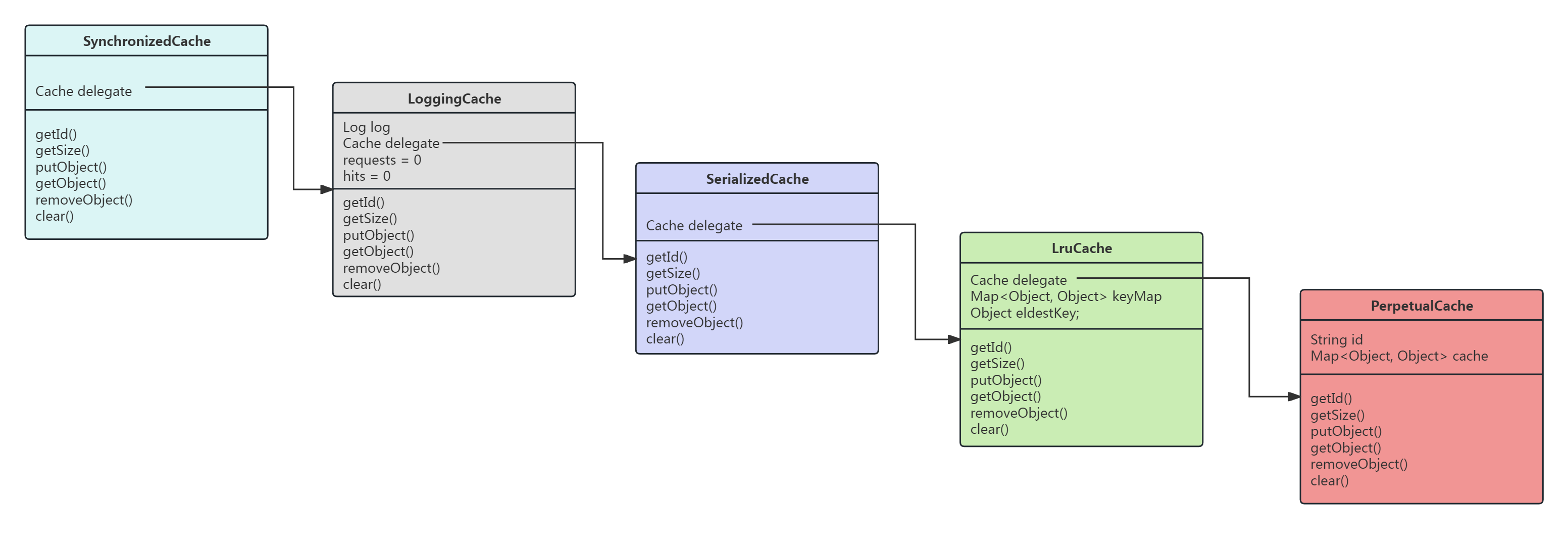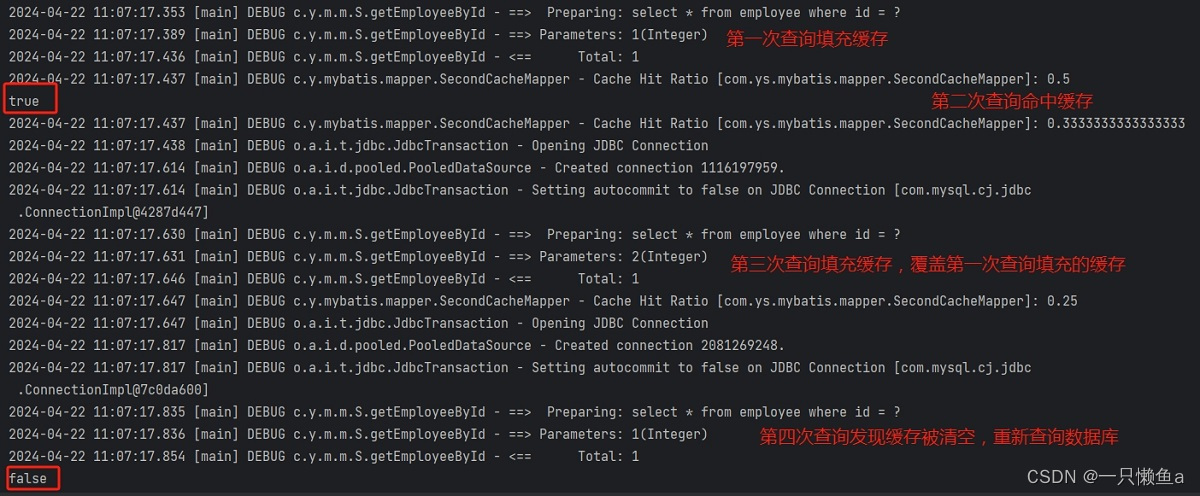如何开启二级缓存
1.在配置文件中,将cacheEnabled属性设置为true (默认true)
<settings>
<setting name="cacheEnabled" value="true"/>
</settings>2.声明缓存空间
2.1 在xml文件中添加<cache/>标签
<?xml version="1.0" encoding="UTF-8"?>
<!DOCTYPE mapper PUBLIC "-//mybatis.org//DTD Mapper 3.0//EN" "http://mybatis.org/dtd/mybatis-3-mapper.dtd">
<mapper namespace="com.ys.mybatis.mapper.SecondCacheMapper">
<cache/>
<select id="getEmployeeById" resultType="com.ys.mybatis.DO.EmployeeDO" >
select * from employee where id = #{id}
</select>
</mapper>2.2 在java文件中添加@CacheNamespace注解
@CacheNamespace
public interface SecondCacheMapper {
@Select("select * from employee")
List<EmployeeDO> listAllEmployee();
}2.3 <cache/> + @CacheNamespaceRef 或 <cache-ref/> + @CacheNamespace
当我们一部分sql写在java文件中,一部分sql写在xml中,并且都希望开启二级缓存,则需要用到<cache/> + @CacheNamespaceRef (或 <cache-ref/> + @CacheNamespace)的组合的形式
<?xml version="1.0" encoding="UTF-8"?>
<!DOCTYPE mapper PUBLIC "-//mybatis.org//DTD Mapper 3.0//EN" "http://mybatis.org/dtd/mybatis-3-mapper.dtd">
<mapper namespace="com.ys.mybatis.mapper.SecondCacheMapper">
<cache/>
<select id="getEmployeeById" resultType="com.ys.mybatis.DO.EmployeeDO" >
select * from employee where id = #{id}
</select>
</mapper>@CacheNamespaceRef(name = "com.ys.mybatis.mapper.SecondCacheMapper")
public interface SecondCacheMapper {
@Select("select * from employee")
List<EmployeeDO> listAllEmployee();
EmployeeDO getEmployeeById(Integer id);
}<cache/> 标签属性
type : 缓存类型。默认PerpetualCache
eviction : 清除策略。默认的清除策略是 LRU
- LRU – 最近最少使用:移除最长时间不被使用的对象。
- FIFO – 先进先出:按对象进入缓存的顺序来移除它们。
- SOFT – 软引用:基于垃圾回收器状态和软引用规则移除对象。
- WEAK – 弱引用:更积极地基于垃圾收集器状态和弱引用规则移除对象。
flushInterval : 刷新间隔。属性可以被设置为任意的正整数,设置的值应该是一个以毫秒为单位的合理时间量。 默认情况是不设置,也就是没有刷新间隔,缓存仅仅会在调用语句时刷新。
size : 引用数目 。属性可以被设置为任意正整数,要注意欲缓存对象的大小和运行环境中可用的内存资源。默认值是 1024。
readOnly : 只读,属性可以被设置为 true 或 false。只读的缓存会给所有调用者返回缓存对象的相同实例。 因此这些对象不能被修改。这就提供了可观的性能提升。而可读写的缓存会(通过序列化)返回缓存对象的拷贝。 速度上会慢一些,但是更安全,因此默认值是 false。
blocking : 是否阻塞,默认false。阻塞的情况下,如果一个sqlSession获取指定cacheKey的二级缓存为null时,在其实时查询数据、填充缓存之前,如果有其他sqlSession也尝试获取该cacheKey的二级缓存,则该sqlSession将处于blocking状态,直到上一个sqlSession将缓存填充完毕
二级缓存的构建
MapperBuilderAssistant#useNewCache
public Cache useNewCache(Class<? extends Cache> typeClass,
Class<? extends Cache> evictionClass,
Long flushInterval,
Integer size,
boolean readWrite,
boolean blocking,
Properties props) {
Cache cache = new CacheBuilder(currentNamespace)
// cache默认的类型是PerpetualCache
.implementation(valueOrDefault(typeClass, PerpetualCache.class))
// 如果未指定装饰器,则添加一个默认的装饰器(LruCache)
.addDecorator(valueOrDefault(evictionClass, LruCache.class))
.clearInterval(flushInterval)
.size(size)
.readWrite(readWrite)
.blocking(blocking)
.properties(props)
.build();
configuration.addCache(cache);
currentCache = cache;
return cache;
}通过源码我们证实了:默认缓存类型是PerpetualCache,默认清除策略是LRU
CacheBuilder#build
public Cache build() {
// 如果未指定默认缓存类型,则设置默认实现为PerpetualCache
// 如果未指定装饰器,则添加一个负责清除缓存的装饰器(LruCache)
setDefaultImplementations();
// 将namespace作为缓存的id,实例化默认缓存对象
Cache cache = newBaseCacheInstance(implementation, id);
// 设置属性
setCacheProperties(cache);
// issue #352, do not apply decorators to custom caches
if (PerpetualCache.class.equals(cache.getClass())) {
for (Class<? extends Cache> decorator : decorators) {
// 循环实例化装饰器Cache,并装饰当前cache
cache = newCacheDecoratorInstance(decorator, cache);
setCacheProperties(cache);
}
// 添加系统默认的装饰器
// ScheduledCache : 如果设置了flushInterval,则添加该装饰器
// SerializedCache : 默认添加
// LoggingCache : 默认添加
// SynchronizedCache : 默认添加
// BlockingCache : 如果设置了blocking,则添加该装饰器
cache = setStandardDecorators(cache);
// 如果cache的最外层的装饰器不是LoggingCache,则cache的最外层再套一个LoggingCache
} else if (!LoggingCache.class.isAssignableFrom(cache.getClass())) {
cache = new LoggingCache(cache);
}
return cache;
}由上述源码,我们得出默认情况下的Cache构造,如下图

可配置的装饰器

各装饰器的作用
- BlockingCache : 防止缓存穿透
- SynchronizedCache : 线程同步
- LoggingCache : 打印二级缓存命中率
- SerializedCache : 序列化、反序列化对象
- ScheduledCache : 定时清除缓存,默认时长1小时
- LruCache : 清除策略
- PerpetualCache : 存储缓存
二级缓存在mybatis中的应用
相关源码 : CachingExecutor#query

前置知识点
CacheKey的组成

- statementId
- rowBounds
- sql
- 参数
- environment
PS : cacheKey相同才有命中缓存的可能,这个cacheKey的组成存在environment,表明不同数据源,二级缓存不会命中
Cache结构

和我们上述分析一致,默认配置下的二级缓存是五级的
flushCache & useCache
XMLStatementBuilder#parseStatementNode

- useCache : select默认true,insert、update、delete默认false
- flushCache : select默认false,insert、update、delete默认true
TransactionalCacheManager
TransactionalCache管理器。其getObject()、putObject()、clear()方法都会调用getTransactionalCache方法将原始的cache再套一个装饰器(TransactionalCache),然后再进行管理
TransactionalCache
开启二级缓存后,并不是所有的查询结果立刻放入二级缓存,而是将其放入暂存区,等执行commit方法后,才会将暂存区的数据put到二级缓存中。TransactionalCache结构如下:
public class TransactionalCache implements Cache {
private static final Log log = LogFactory.getLog(TransactionalCache.class);
private final Cache delegate;
private boolean clearOnCommit;
private final Map<Object, Object> entriesToAddOnCommit;
private final Set<Object> entriesMissedInCache;
}- clearOnCommit : 提交前,是否清除当前命名空间所有二级缓存
- entriesToAddOnCommit : 暂存区数据
分析CachingExecutor的query方法

关注点 1 : flushCacheIfRequired方法
private void flushCacheIfRequired(MappedStatement ms) {
Cache cache = ms.getCache();
if (cache != null && ms.isFlushCacheRequired()) {
tcm.clear(cache);
}
}
public void clear(Cache cache) {
getTransactionalCache(cache).clear();
}
private TransactionalCache getTransactionalCache(Cache cache) {
return transactionalCaches.computeIfAbsent(cache, TransactionalCache::new);
}
@Override
public void clear() {
clearOnCommit = true;
entriesToAddOnCommit.clear();
}通过上述的方法调用,我们可以得出以下两点 :
- 只有手动设置flushCache为true的增删改查,或者默认情况下的增删改,才会执行TransactionalCacheManager的clear方法
- TransactionalCacheManager的clear方法,会将当前cache再套一层装饰器(TransactionalCache),然后将属性clearOnCommit设置为true,并清空暂存区的数据
关注点 2 : if成立的条件
只有useCache为true的查询,才能可能使用到二级缓存,并且增删改不可以设置其值为true。
关注点 3 : getObject方法
public Object getObject(Cache cache, CacheKey key) {
return getTransactionalCache(cache).getObject(key);
}
private TransactionalCache getTransactionalCache(Cache cache) {
return transactionalCaches.computeIfAbsent(cache, TransactionalCache::new);
}
@Override
public Object getObject(Object key) {
// issue #116
Object object = delegate.getObject(key);
if (object == null) {
entriesMissedInCache.add(key);
}
// issue #146
if (clearOnCommit) {
return null;
} else {
return object;
}
}cache的getObject()方法也会将原本的cache再套一层装饰器(TransactionalCache),如果之前执行过 flushCacheIfRequired 方法(该方法会将 clearOnCommit 设置为true)则会返回 null,即使命中二级缓存(防止脏数据)
获取二级缓存的条件
根据我们对CachingExecutor的query方法进行分析,我们总结一下可以命中二级缓存的条件 :
- 全局缓存设置cacheEnabled为true(默认为true)
- 指定命名空间中存在<cache/>标签或者@CacheNamespace注解
- MappedStatement的flushCache属性为false (如果属性为true,则会执行flushCacheIfRequired方法,该方法会将clearOnCommit属性设置为true,执行getObject方法将会一直返回null)
- MappedStatement的useCache属性为true (只有<select>标签才有可能为true)
- 存在二级缓存 (即填充缓存的会话已经提交)
二级缓存测试
二级缓存命中测试
创建mybatis配置文件mybatis-config.xml
<?xml version="1.0" encoding="UTF-8" ?>
<!DOCTYPE configuration
PUBLIC "-//mybatis.org//DTD Config 3.0//EN"
"http://mybatis.org/dtd/mybatis-3-config.dtd">
<configuration>
<properties>
<property name="driver" value="com.mysql.cj.jdbc.Driver"/>
<property name="url" value="jdbc:mysql://127.0.0.1/test?useUnicode=true&characterEncoding=utf-8&useSSL=false&serverTimezone=Asia/Shanghai&allowPublicKeyRetrieval=true"/>
<property name="username" value="root"/>
<property name="password" value="123456"/>
</properties>
<settings>
<setting name="cacheEnabled" value="true"/>
<setting name="mapUnderscoreToCamelCase" value="true"/>
</settings>
<environments default="default">
<environment id="default">
<transactionManager type="JDBC"/>
<dataSource type="POOLED">
<property name="driver" value="${driver}"/>
<property name="url" value="${url}"/>
<property name="username" value="${username}"/>
<property name="password" value="${password}"/>
</dataSource>
</environment>
</environments>
<mappers>
<mapper resource="mapper/SecondCacheMapper.xml" />
</mappers>
</configuration>创建SecondCacheMapper.xml
<?xml version="1.0" encoding="UTF-8"?>
<!DOCTYPE mapper PUBLIC "-//mybatis.org//DTD Mapper 3.0//EN" "http://mybatis.org/dtd/mybatis-3-mapper.dtd">
<mapper namespace="com.ys.mybatis.mapper.SecondCacheMapper">
<cache />
<select id="getEmployeeById" resultType="com.ys.mybatis.DO.EmployeeDO" >
select * from employee where id = #{id}
</select>
</mapper>创建SecondCacheMapper
@CacheNamespaceRef(name = "com.ys.mybatis.mapper.SecondCacheMapper")
public interface SecondCacheMapper {
@Select("select * from employee")
List<EmployeeDO> listAllEmployee();
EmployeeDO getEmployeeById(Integer id);
}创建测试类SecondCacheTest
@Slf4j
public class SecondCacheTest {
private SqlSessionFactory sqlSessionFactory;
@BeforeEach
public void before() {
InputStream inputStream = ConfigurationTest.class.getClassLoader().getResourceAsStream("mybatis-config.xml");
sqlSessionFactory = new SqlSessionFactoryBuilder().build(inputStream);
}
@Test
public void hitL2Cache() {
SqlSession firstSession = sqlSessionFactory.openSession();
SecondCacheMapper firstMapper = firstSession.getMapper(SecondCacheMapper.class);
EmployeeDO firstResult = firstMapper.getEmployeeById(1);
firstSession.commit();
SqlSession secondSession = sqlSessionFactory.openSession();
SecondCacheMapper secondMapper = secondSession.getMapper(SecondCacheMapper.class);
EmployeeDO secondResult = secondMapper.getEmployeeById(1);
System.out.println(firstResult == secondResult);
}
}执行测试方法

LoggingCache打印了命中率 : 0.5
但是我们发现,第一次查询的结果和第二次查询的结果并不相等,那是因为<cache/>标签的readOnly属性默认为false,那样装饰器链上就会存在SerializedCache,SerializedCache在存取二级缓存的时候会序列化、反序列化对象,所以存取的对象并不是同一个对象了
我们将<cache/>标签的readOnly属性设置为true,再进行测试
<cache readOnly="true" />
修改默认值测试
二级缓存存在多个装饰器,每个装饰器的属性可能存在默认值,那如何修改这些默认值,我们来一起探究一下。假如我们将清除策略修改为FIFO,size设置为1(默认1024)
<cache readOnly="true" eviction="FIFO">
<property name="size" value="1"/>
</cache>@Test
public void testCacheSize() {
SqlSession firstSession = sqlSessionFactory.openSession();
SecondCacheMapper firstMapper = firstSession.getMapper(SecondCacheMapper.class);
EmployeeDO firstResult = firstMapper.getEmployeeById(1);
// 填充第一个缓存
firstSession.commit();
SqlSession secondSession = sqlSessionFactory.openSession();
SecondCacheMapper secondMapper = secondSession.getMapper(SecondCacheMapper.class);
EmployeeDO secondResult = secondMapper.getEmployeeById(1);
System.out.println(firstResult == secondResult);
SqlSession thirdSession = sqlSessionFactory.openSession();
SecondCacheMapper thirdMapper = thirdSession.getMapper(SecondCacheMapper.class);
thirdMapper.getEmployeeById(2);
// 填充第二个缓存,覆盖第一个缓存
thirdSession.commit();
SqlSession fourthSession = sqlSessionFactory.openSession();
SecondCacheMapper fourthMapper = fourthSession.getMapper(SecondCacheMapper.class);
EmployeeDO fourthResult = fourthMapper.getEmployeeById(1);
// 看看size是否为1 (需不需要查询数据库)
System.out.println(firstResult == fourthResult);
}
通过日志我们可以发现,默认属性覆盖成功
二级缓存存在的问题
如果系统允许一定时间内的数据不一致问题,我们才有可能使用二级缓存,如果是高实时性的业务,最好不要使用二级缓存。除了数据一致性问题,我们再来讨论一下二级缓存可能存在的其他问题:
内存占用
默认情况下,存储数据的是PerpetualCache,该Cache是把数据存储在内存中,给内存带来了一定的挑战
缓存更新时,存在效率问题
考虑到数据安全的问题,mybatis中存在BlockingCache、SynchronizedCache。如果在更新缓存的时候,出现高并发问题,阻塞、同步方式的请求可能会拖垮服务器
时效低
默认情况下,我们只要执行了增删改操作,该命名空间下的所有二级缓存都将被清空。有可能我们刚填充完二级缓存,下一步就会执行增删改操作,将该命名空间下二级缓存都清空了